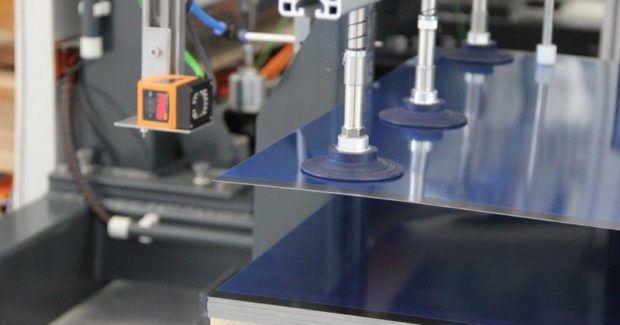Gripper System for Stainless Sheet Metal Handling Eliminates Manual Labor
This custom End-of-Arm-Tooling system from FIPA automates sheet metal processing by using flat vacuum cups and compact ejectors to apply suction to single pieces of sheet metal in a designated stack at the pick-up site.
Posted: April 3, 2017
FIPA Inc. (Cary, NC), a leading manufacturer of advanced vacuum technology, gripper systems, air nippers, tube lifters, and End-of-Arm-Tooling (EOAT), recently created a custom EOAT system that facilitates the removal of protective film from sheet metal with a cost and labor saving automated process. Developed for Foilpuller GmbH (Bobingen, Germany), a stainless steel sheet metal processing firm, this system combines long lifecycle, high holding force vacuum cups with pressure regulating, air-saving compact ejectors to deliver reliable, non-slip sheet metal handling. Featuring rapid cycle times of 30 seconds to 45 seconds, the CNC-controlled system at Foilpuller uses EOAT and vacuum technology to automate film removal for metal sheets used in white goods, eliminating tedious manual labor and delivering up to 97 percent savings in overall operating costs over standard vacuum generators.
This patented system automates the processing of sheet metal in standard sizes of 1 m x 2.5 m using flat vacuum cups and compact ejectors to apply suction to single pieces of sheet metal in a designated stack at the pick-up site. The vacuum cups prevent wobbling while a vacuum shuttle delivers the sheet to a worktable where a cutting wheel lightly scores the protective film on the surface of the sheet. Through precisely controlled cutting, the wheel only makes incisions where film needs to be removed to allow for mounting fittings, hinges, cutouts, and welding work, leaving the rest of the protective film intact. A scraper then removes the scored film to reveal a residue-free surface before the gripper system places the sheet in a second designated stack for further processing. “This system with EOAT and vacuum technology has already proven the exceptional reliability of its continuous operation with more than 100,000 successfully processed sheets at Foilpuller,” said Rainer Mehrer, the president of FIPA. “Our engineers worked closely with their shop to develop this new system, assisting them with everything from the initial consultation, project planning, development, and construction, through to the startup of operations.”
The SM-F Series flat vacuum cups used in this system feature a flexible sealing lip for optimal, non-slip contact with sheet metal and are suitable for almost all standard metal surfaces, including flat or textured stainless steel, varnished steel metal, coated plates, and printed film. The series’ reinforcement ribs provide a high degree of slip resistance, effectively absorb the high lateral forces that result from maneuvers like tipping metal sheets, and prevent unwanted deep-drawing effects that could warp thin metal sheets. Made of silicone-free NBR materials with a hardness of 60 deg Shore A, the vacuum cups also feature a vulcanized aluminum connection thread (available in several different options) designed to both minimize leaking and ensure a tight fit, even during dynamic gripping cycles. The rugged EMA Series compact ejectors combine a pressure regulating, energy-saving function with an electronic air saving function to achieve outstanding operational efficiency for the system. Designed to provide maximum energy savings without limiting the overall performance, the ejectors supply a Venturi nozzle with compressed air to generate a vacuum, allowing the attached vacuum cup to quickly grip the workpiece. A vacuum switch continually monitors the vacuum level to control air savings and triggers the “item gripped” signal at the first vacuum threshold limit (V1, 65 percent), allowing the scheduled item transfer to take place. When the vacuum reaches the second threshold limit (V2, 75 percent), the ejector interrupts the compressed air supply to the Venturi nozzle, reducing energy consumption to zero.
The vacuum is sustained by a closed, non-return valve and continues to reliably grip the workpiece without any additional energy expenditure until naturally occurring leakage eventually lowers the vacuum threshold back to 65 percent, at which point the air-saving control cycle briefly generates a new vacuum until the 75 percent threshold is again achieved. Once the item transfer is completed, the ejector’s blow-off valve generates a manually adjustable air jet to quickly release the metal sheet.
FIPA Inc., 1855 Evans Road, Cary, NC 27513, 919-651-9888, Fax: 919-573-0871, [email protected], www.fipa.com.














